Timberland Hiking Boots Women: Step Into the Ultimate Outdoor Adventure Guide
1. Introduction to Hiking Boots
Hiking is more than a physical activity; it’s a journey that connects us with the great outdoors. Ensuring a safe and enjoyable experience hinges on having the right equipment, especially “Timberland hiking boots women,” renowned for their exceptional quality and reliability. Timberland, as a leading brand, offers durable and stylish boots that have been the preferred choice for women outdoor enthusiasts for decades.
2. Why Choose Timberland Hiking Boots for Women?
When embarking on outdoor adventures, the right footwear is not just a necessity, it’s a game-changer. Among the myriad of options available, Timberland hiking boots for women stand out for their exceptional blend of functionality and style. Let’s delve into why these boots are a top choice for female hikers and outdoor enthusiasts.
Unmatched Durability and Comfort
- Built to Last: Timberland boots are renowned for their robust construction. They are crafted using high-quality materials that withstand the test of time and terrain. Whether you’re navigating rocky paths or trekking through muddy trails, these boots are designed to endure the challenges without wearing down.
- Comfort on the Trail: The comfort factor is a critical component in any hiking boot, and Timberland understands this well. Their boots are equipped with features like cushioned footbeds, shock-absorbing midsoles, and supportive ankle padding. This attention to comfort ensures that long hikes are more about enjoying the scenery and less about foot fatigue.
- Fit for All Feet: Timberland offers a range of sizes, including options for wider feet, ensuring that every woman finds her perfect fit. A good fit is crucial not only for comfort but also for preventing blisters and maintaining stability on uneven ground.
Style Meets the Great Outdoors
- Fashion-Forward Designs: Gone are the days when hiking boots were purely utilitarian in appearance. Timberland hiking boots for women are a testament to the fact that function and fashion can coexist. With sleek designs and a variety of colors, these boots transition seamlessly from a rugged trail to casual urban wear.
- Versatility in Style: Whether you prefer a classic look or something more modern and trendy, Timberland has you covered. Their range includes traditional leather boots, contemporary lightweight models, and even waterproof options for those wet adventures.
- Making a Statement: Timberland boots don’t just serve a practical purpose; they also make a style statement. Wearing them reflects a sense of adventure and an appreciation for quality, making them a popular choice for women who want to showcase their outdoor enthusiasm in style.
3. Review of Best Timberland Hiking Boots for Women
Hiking boots are a crucial component for any outdoor adventure, and Timberland offers a range of options catering to different needs and preferences. Here’s an in-depth review of seven popular Timberland hiking boots for women.
1. Timberland Women’s White Ledge Mid Ankle Boot
- Pros:
- Waterproof premium leather upper ensures dry feet in wet conditions.
- The D-ring lacing system provides a secure and adjustable fit.
- Fully gusseted tongue keeps debris out.
- OrthoLite footbed offers comfortable cushioning.
- ReBOTL fabric lining, eco-conscious and durable.
- Cons:
- Limited color options may not appeal to all styles.
- Some users might find the ankle support insufficient for very rugged terrain.
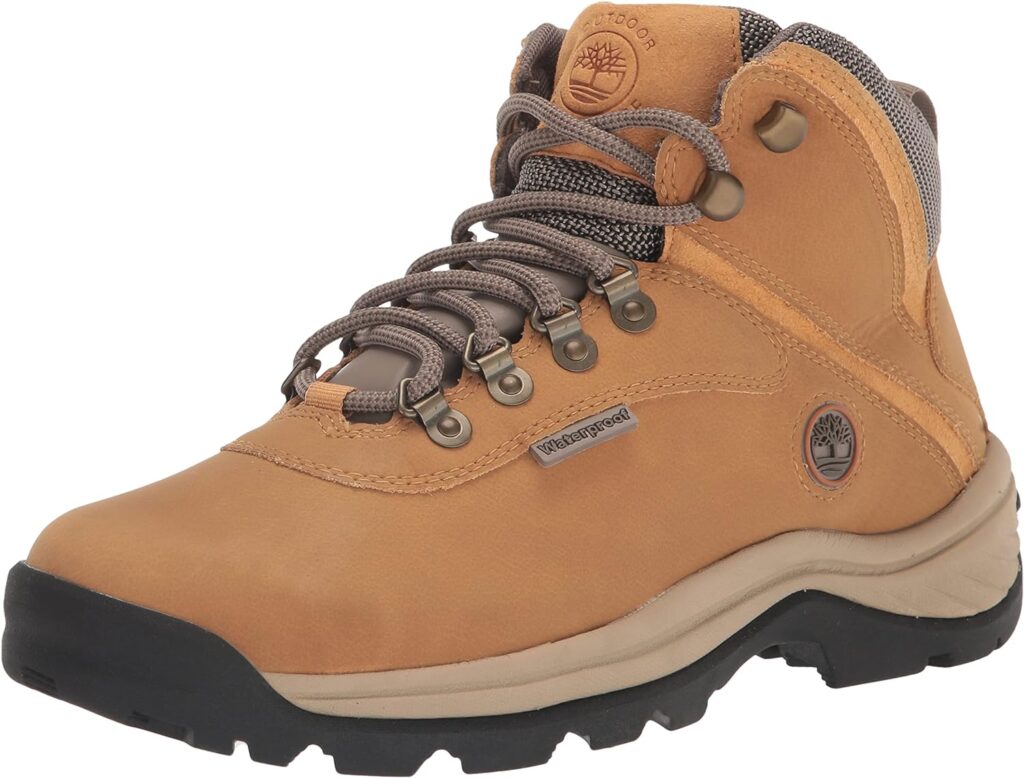
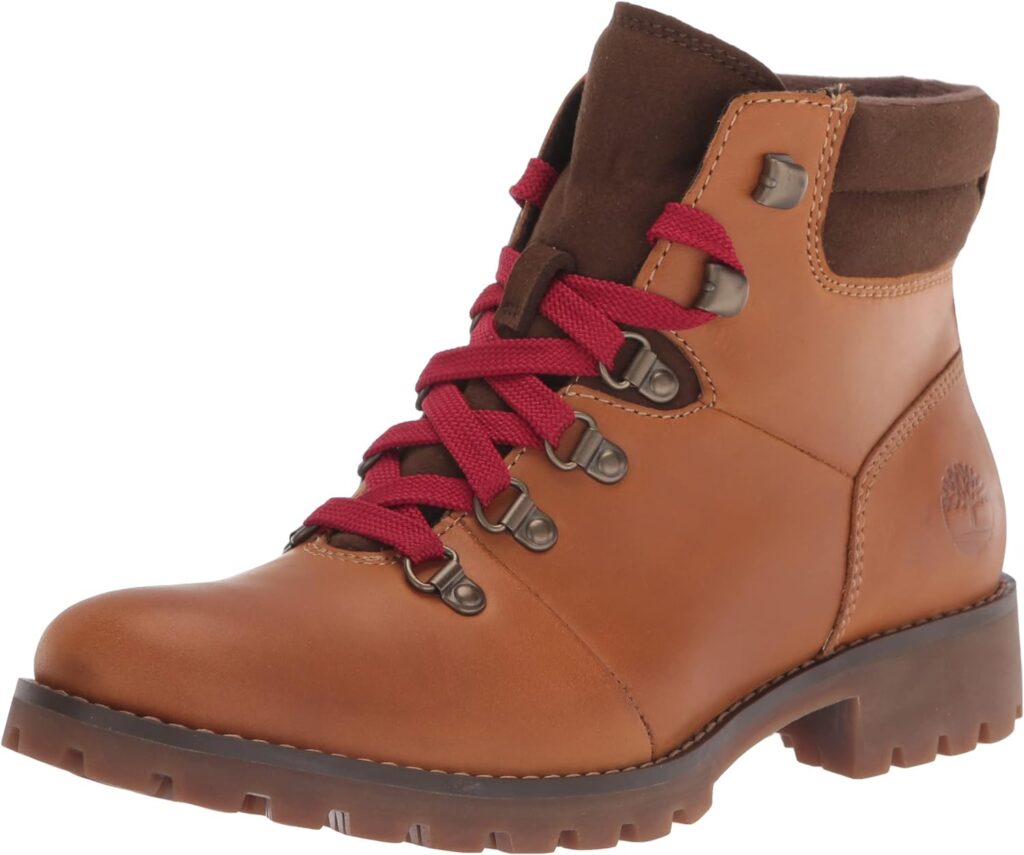
2. Timberland Women’s Ellendale Hiking Boot
- Pros:
- Made with Better Leather from environmentally responsible tanneries.
- Lightweight OrthoLite footbed for comfort.
- Defender Repellent Systems treatment for added durability.
- D-ring lacing system for a customized fit.
- Cons:
- Price variation based on size and color.
- May require a break-in period for optimal comfort.
3. Timberland Women’s Chocorua Trail Boot
- Pros:
- Gore-Tex membrane for waterproof protection.
- Durable rubber lug outsole for excellent traction.
- Versatile design suitable for trails and casual wear.
- Machine washable for easy maintenance.
- Cons:
- Higher price point compared to some other models.
- Limited breathability in very hot conditions.
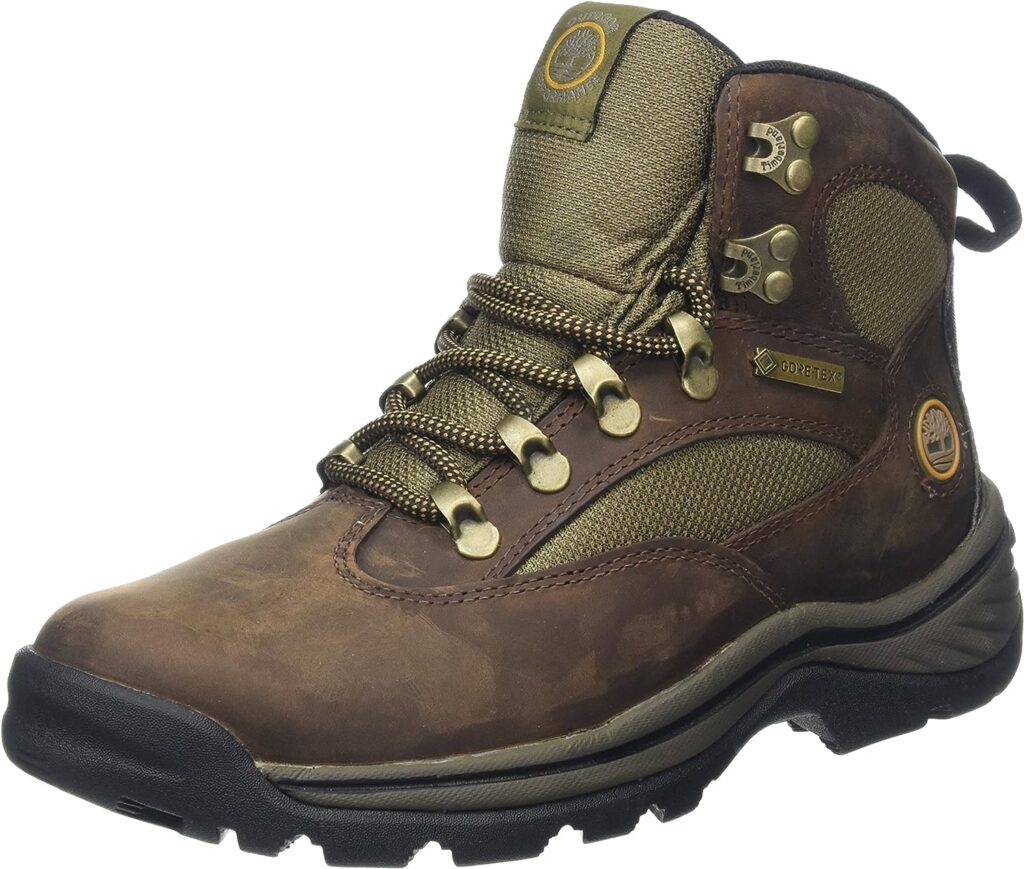
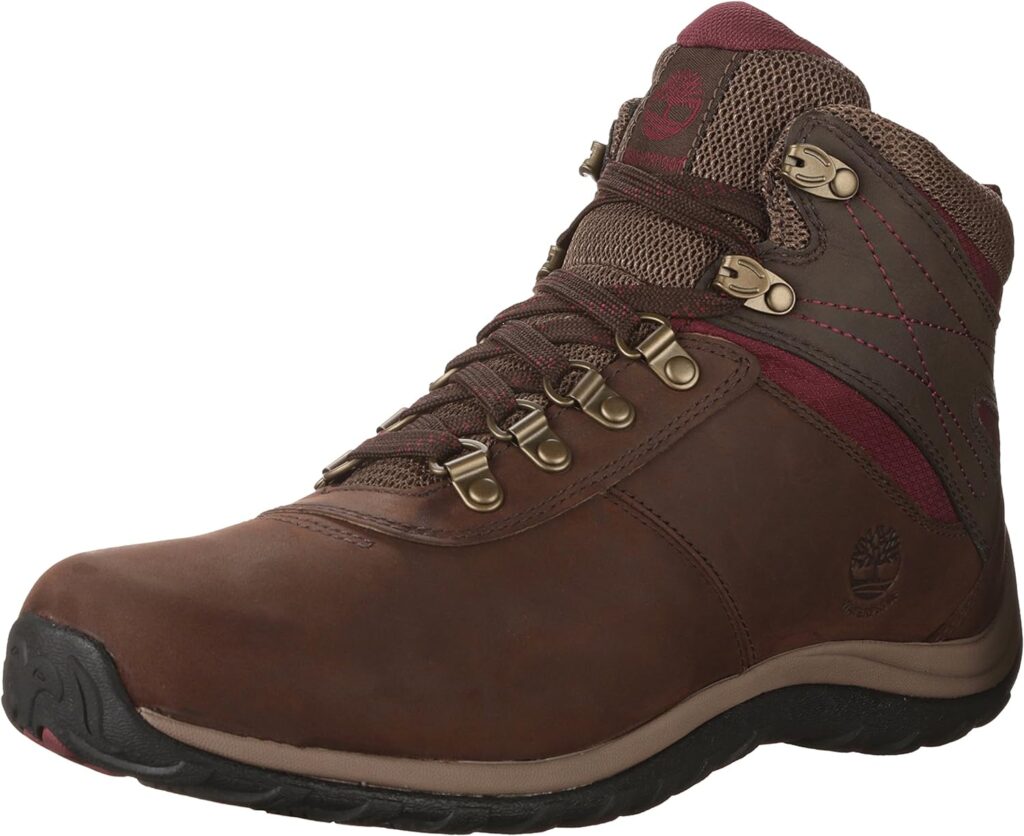
4. Timberland Women’s Norwood Mid Waterproof
- Pros:
- Premium waterproof leather and fabric upper.
- Waterproof membrane for dry feet in wet conditions.
- Durable 34% recycled rubber outsole with good traction.
- Fully gusseted tongue to keep out debris.
- Cons:
- Some users might find the design bulky.
- Limited cushioning compared to other models.
5. Timberland Women’s Kinsley 6-inch Waterproof Hiking Boot
- Pros:
- Eco-friendly Better Leather from a rated tannery.
- Durable and waterproof, suitable for various conditions.
- Stylish design that transitions well from trail to casual wear.
- Cons:
- Only available in one color option (Black Nubuck).
- May not provide enough ankle support for extremely rough terrains.
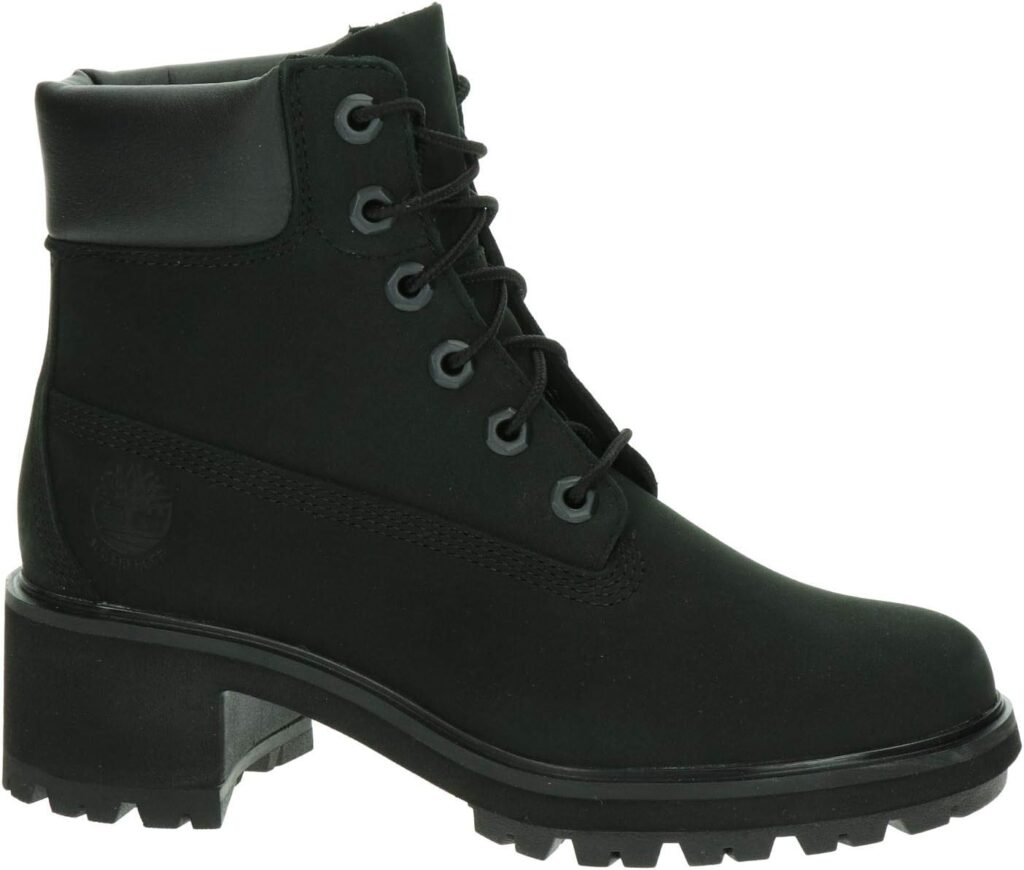
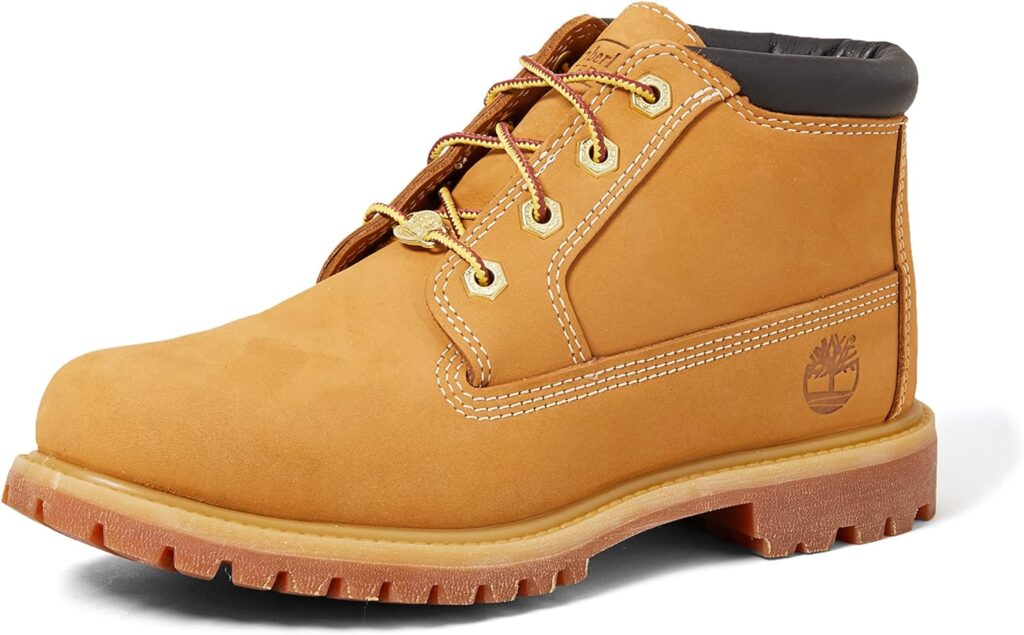
6. Timberland Women’s Nellie Double Waterproof Ankle Boot
- Pros:
- Classic, versatile style for both outdoor and casual use.
- Premium full-grain waterproof leather uppers.
- Comprehensive warranty coverage for peace of mind.
- Cons:
- Some users may find them heavy for long hikes.
- The fashion-focused design may compromise rugged functionality.
7. Timberland Women’s 14 Inch Premium WP Knee-High Boot
- Pros:
- Offers extensive water protection from toe to knee.
- High-rise, lace-up design for unique urban-outdoor style.
- Made with sustainable and recycled materials.
- Cons:
- Higher price range.
- The knee-high style might not be suitable for intense hiking activities.
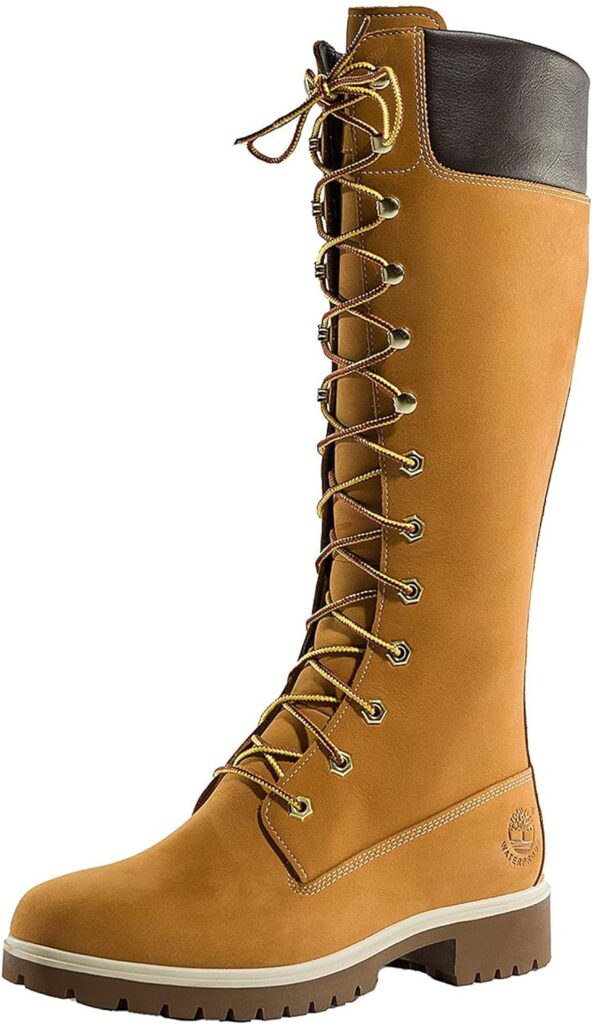
Each of these Timberland hiking boots for women brings something unique to the table, whether it’s the style, environmental consciousness, or specific features like waterproofing and comfort. Choosing the right pair depends on individual needs, preferences, and the nature of the outdoor activities planned.
4. How to Maintain Your Timberland Hiking Boots
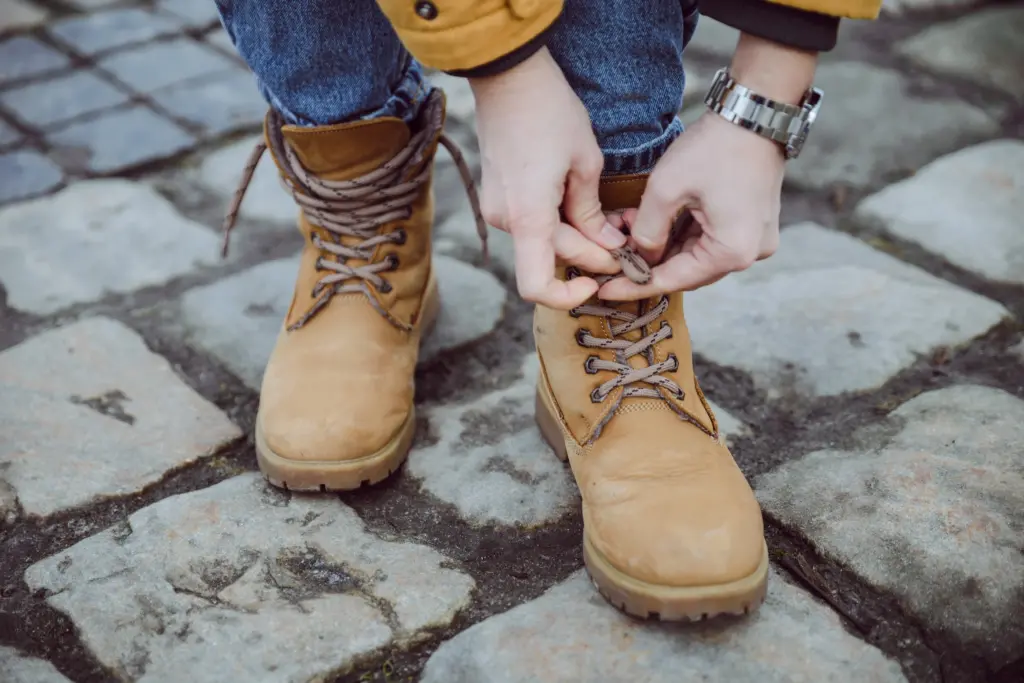
Proper maintenance of your Timberland hiking boots is crucial to extend their life and ensure they continue to provide the performance and comfort you need on your hikes. Here’s a comprehensive guide on how to keep your Timberland boots in top condition.
Cleaning and Care Tips
- Post-Hike Cleaning: The first step in boot maintenance is to clean them after each hike. Remove any dirt, mud, or debris using a soft-bristle brush. This prevents the build-up of grime, which can degrade the material over time.
- Appropriate Cleaning Methods: For general cleaning, use a specialized boot cleaner that is appropriate for the boot material. Avoid harsh chemicals or household cleaners that can damage the boot’s fabric or leather.
- Focus on Leather Care: If your Timberland boots are made of leather, regular conditioning is vital. Use a quality leather conditioner to keep the leather soft and prevent it from drying out and cracking. This not only maintains the boot’s appearance but also its durability.
- Drying Your Boots: After cleaning, let your boots air dry naturally. Avoid direct heat sources like radiators or hairdryers, as intense heat can warp the shape of the boots and weaken the material.
Long-term Maintenance Advice
- Proper Storage: Store your Timberland boots in a cool, dry place when not in use. Excessive heat and humidity can lead to material degradation, while direct sunlight can fade the color.
- Regular Inspection: Periodically inspect your boots for signs of wear and tear. Pay special attention to the soles and laces, as these are high-wear areas. Early detection of issues like loose soles or frayed laces can prevent more significant problems down the line.
- Maintaining Water Resistance: If your boots are waterproof, use a waterproofing spray periodically to maintain their resistance to water. This is especially important if you frequently hike in wet conditions. Reapply the waterproofing treatment according to the product’s instructions and after intensive cleaning sessions.
- Replacing Worn Parts: Be proactive about replacing worn-out parts, such as insoles or laces. This not only ensures comfort but also affects the overall functionality and safety of your boots.
- Seek Professional Help for Major Repairs: For significant issues like a detached sole or torn material, consider getting your boots repaired by a professional. This can be more cost-effective than purchasing a new pair and is also a more sustainable approach.
5. Choosing the Right Fit for Your Hiking Boots
Selecting hiking boots with the right fit is crucial for ensuring comfort during your outdoor adventures, as well as for maintaining foot health. Timberland offers a variety of sizes and styles, but knowing how to find the perfect fit is key. Here’s a detailed guide to help you make sure your Timberland boots fit perfectly.
Measuring Your Foot Size Accurately
- Using the Right Tools: The most accurate way to measure your foot size is to use a Brannock device, which you can find at most shoe stores. This device provides precise measurements for the length and width of your feet.
- DIY Measurement at Home: If you don’t have access to a Brannock device, you can measure your foot size at home using a ruler. Place your foot on a piece of paper, draw a line at the heel and the longest toe, and then measure the distance between these two points.
- Best Time to Measure: Feet can swell slightly throughout the day due to walking and standing. Therefore, it’s advisable to measure your feet in the afternoon or evening when they are at their largest to ensure the best fit.
- Accounting for Foot Shape and Arch Type: Consider any specific characteristics of your feet, such as high arches or flat feet, as these can affect the fit of the boot.
Understanding Boot Sizes and Widths
- Size Variations: Timberland boots come in a range of sizes and widths to cater to different foot shapes. It’s important to understand that boot sizes can vary slightly from regular shoe sizes.
- Room for Movement: Ensure there is enough room in the toe box. Your toes shouldn’t feel cramped, and there should be about a thumb’s width of space between the end of the boot and your longest toe.
- Width Matters: Pay attention to the width of the boots. Timberland provides options for various foot widths. Boots that are too narrow can cause discomfort and circulation issues, while too wide can lead to instability and blisters.
- Consider Your Socks: The socks you plan to wear with your boots can significantly affect the fit. Thicker socks used for hiking require more room, so you might need to go up half a size to accommodate them.
- Trying Them On: When trying on Timberland boots, do so with the socks you intend to hike in. Walk around to ensure there is no pinching or slipping. Your heel should stay in place without lifting, and you should be able to wiggle your toes freely.
- Break-In Period: Keep in mind that many hiking boots have a break-in period. They may feel stiff at first but will become more comfortable as the material molds to your feet. However, they should still feel right in terms of length and width from the start.
6. Enhancing Your Hiking Experience with the Right Boots

Importance of a Good Fit
- Preventing Blisters and Injuries: One of the main reasons a good fit is crucial is to prevent blisters, which are often caused by friction from ill-fitting boots. Additionally, a well-fitting boot minimizes the risk of ankle sprains and other injuries by providing adequate support.
- Enhancing Balance and Stability: On uneven or slippery terrain, a boot that fits well aids in maintaining balance and stability. This is especially important when navigating challenging trails or carrying a backpack, as it reduces the risk of falls and injuries.
- Improved Comfort: A boot that fits properly is more comfortable, reducing foot fatigue and allowing you to enjoy longer hikes without discomfort.
Additional Accessories for Hiking Boots
- Insoles for Added Comfort: Many hikers find that adding specialized insoles to their boots enhances comfort. Insoles can provide additional cushioning, support, and even correct foot alignment, which is beneficial for those with flat feet or high arches.
- Gaiters for Protection: Gaiters are a useful accessory for hikers. They wrap around your lower leg and cover the top of your boot, protecting your legs from scratches, bites, and debris. They are particularly useful in snowy conditions, dense underbrush, or when crossing streams.
7. Common Questions and Concerns About Hiking Boots
Breaking In New Boots
- Gradual Break-In Process: New boots often require a break-in period to mold to the shape of your feet. Start by wearing them around the house for short periods. This helps the material to soften and shape without putting too much strain on your feet.
- Increasing Wear Time Gradually: Gradually increase the amount of time you wear your boots, including short walks or hikes. This gradual process helps to avoid blisters and discomfort that can occur when wearing new boots for extended periods immediately.
When to Replace Your Boots
- Monitoring for Wear and Tear: Regularly inspect your boots for signs of wear, such as thinning soles, worn-down treads, or damaged uppers. These signs can reduce the effectiveness of your boots, compromising your safety and comfort.
- Signs It’s Time for a New Pair: If your boots no longer provide the support and comfort they once did, or if you start experiencing discomfort or blisters where you didn’t before, it might be time to consider a new pair. The lifespan of a boot varies depending on usage, terrain, and maintenance, but being proactive about replacement is key to ensuring continuous support and comfort on your hikes.
8. Comparing Timberland to Other Brands
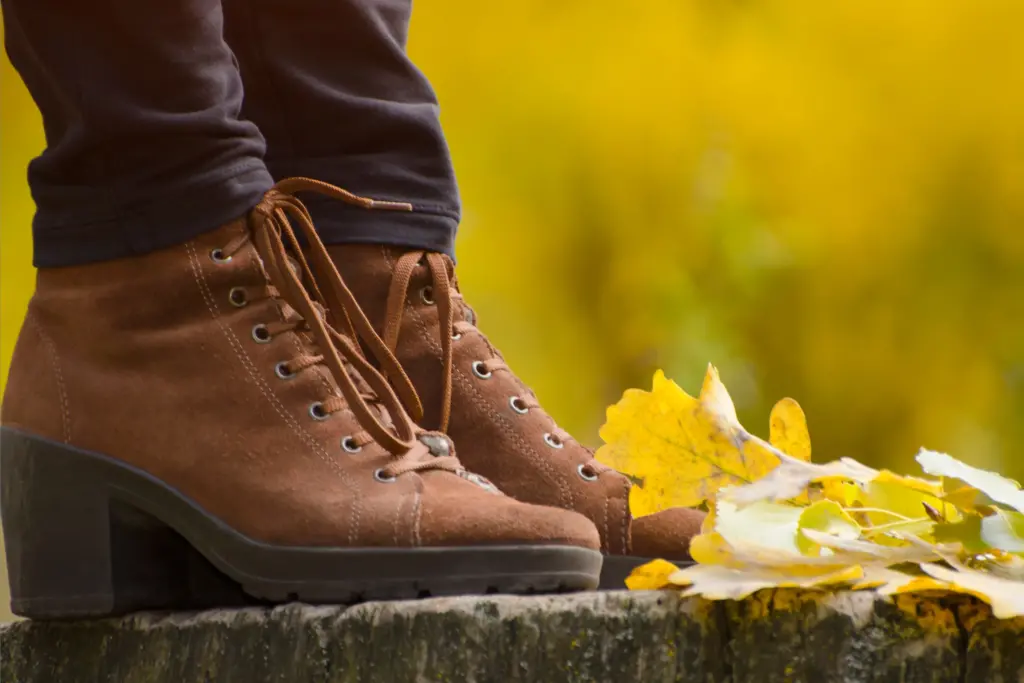
What Sets Timberland Apart?
- Renowned Durability: Timberland boots have earned a reputation for their rugged durability. Crafted to withstand the most challenging environments, these boots are designed for longevity, reducing the need for frequent replacements.
- Stylish and Functional Designs: Unlike some other brands that focus solely on function, Timberland successfully merges style with practicality. Their boots are not only robust and reliable for hiking but also fashionable enough for casual wear.
- Innovative Technologies: Timberland consistently incorporates cutting-edge technologies in their boots. Features like anti-fatigue technology, waterproof membranes, and Primaloft insulation set them apart, enhancing comfort and performance on the trails.
Price vs. Quality Comparison
- Value for Money: Timberland boots may come with a higher price tag compared to some other brands, but they offer excellent value. The longevity, durability, and quality of their boots make them a worthwhile investment for serious hikers and outdoor enthusiasts.
- Commitment to Quality and Sustainability: Timberland’s pricing reflects their commitment to quality materials and sustainable manufacturing practices. This focus on sustainability is not only good for the environment but also ensures that the boots are made to the highest standards.
9. Sustainability and Ethical Considerations
Timberland’s Environmental Initiatives
- Reducing Environmental Footprint: Timberland is dedicated to minimizing its impact on the environment. This commitment is evident in their use of recycled materials in many of their products, significantly reducing waste and resource consumption.
- Reforestation Efforts and Carbon Neutrality: The brand is actively involved in reforestation projects around the world. These efforts not only contribute to carbon neutrality goals but also promote biodiversity and environmental restoration.
Ethical Manufacturing Processes
- Transparent Manufacturing: Timberland prides itself on transparency in its manufacturing processes. The brand ensures that its factories adhere to strict standards regarding labor practices and working conditions.
- Responsible Supply Chain: Timberland’s ethical practices extend beyond their factories to their entire supply chain. By fostering a responsible and sustainable business model, they ensure that every step of the production process aligns with their high ethical and environmental standards.
10. Tips for First-Time Hiking Boot Buyers
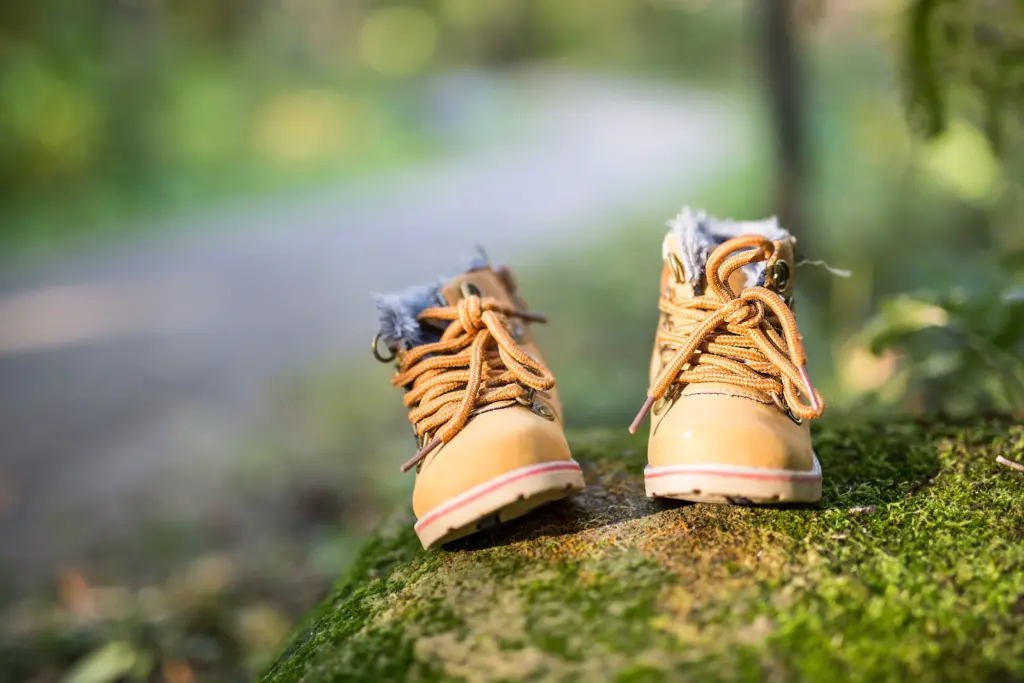
What to Look for in a Boot
- Balancing Key Features: When selecting your first pair of hiking boots, prioritize a balance between comfort, durability, and support. Each element plays a crucial role in enhancing your hiking experience.
- Suitability for Trail Types: Consider the terrain you’ll primarily be hiking on. Lightweight boots are ideal for well-maintained trails, while rugged, more durable boots are better for challenging terrains.
- Material and Build: Look for high-quality materials that offer breathability and water resistance. The construction of the boot should support your foot and ankle, especially on uneven surfaces.
Avoiding Common Mistakes
- Ensuring Proper Fit: A common mistake is not paying enough attention to the fit. Both overly tight and too loose boots can lead to discomfort and injuries. Spend time trying on different sizes and walking in them.
- Function Over Fashion: While aesthetics are important, functionality should be your primary concern. Choose boots based on how well they meet your hiking needs rather than solely on their appearance.
11. Adventures Awaiting with Timberland Boots
Ideal Destinations for Timberland Boots
- Versatility Across Terrains: Timberland boots are designed for versatility, making them suitable for a range of environments, from the rugged Appalachian Trail to serene walks in your local park.
- Adaptability to Various Landscapes: Whether you are exploring dense forests, trekking up mountains, or traversing coastal paths, Timberland boots offer the necessary support and protection.
Preparing for Different Terrains
- Ankle Support for Challenging Terrains: For hikes involving rocky or uneven terrain, choose boots with strong ankle support to prevent sprains or injuries.
- Waterproof Options for Wet Conditions: If you anticipate hiking in rainy weather or crossing streams, waterproof boots are essential to keep your feet dry and comfortable.
12. The Future of Hiking Boots
Innovations in Boot Technology
- Advancements in Materials: The hiking boot industry is continually evolving, with new materials offering greater durability and sustainability. Future boots may feature even more advanced waterproofing and breathability.
- Focus on Comfort and Foot Health: Emerging technologies aim to enhance comfort and reduce foot fatigue, crucial for long-distance hikers. This includes improvements in cushioning and ergonomic designs.
Anticipated Trends in Hiking Footwear
- Eco-Friendly Production: There is a growing trend towards more environmentally friendly production methods in the hiking boot industry, focusing on reducing carbon footprints and using sustainable materials.
- Smart Technology Integration: The future may see the integration of smart technology in hiking boots, offering features like GPS tracking, performance monitoring, and enhanced safety features.
13. Conclusion: Embracing the Outdoors with Confidence
In conclusion, Timberland hiking boots for women are an excellent choice for anyone looking to explore the outdoors. With their blend of durability, comfort, and style, these boots are designed to enhance your hiking experience. Whether you are a seasoned hiker or a beginner, investing in a good pair of Timberland boots is a step towards many memorable adventures. So lace up your boots, hit the trails, and embrace the beauty of nature with confidence and comfort.
14. FAQs
- How long do Timberland hiking boots typically last?
With proper care, Timberland boots can last several years, even with frequent use. - Are Timberland boots suitable for all weather conditions?
While they are highly durable, specific models are better suited for certain conditions. Waterproof models are ideal for wet conditions, while lighter models are better for hot weather. - Can I wear Timberland hiking boots casually, off the trails?
Absolutely! One of the great things about Timberland boots is their stylish design, making them suitable for casual wear as well. - How do I know if I need a wide size in Timberland boots?
If you often find regular shoes tight or uncomfortable, consider trying a wide size. Measuring your feet and consulting Timberland’s sizing chart can also help. - Is it necessary to break in Timberland boots before a long hike?
Yes, it’s advisable to break in any new hiking boots to avoid discomfort or blisters on longer hikes.
Resources
https://www.mec.ca/en/explore/how-to-clean-and-waterproof-hiking-boots




